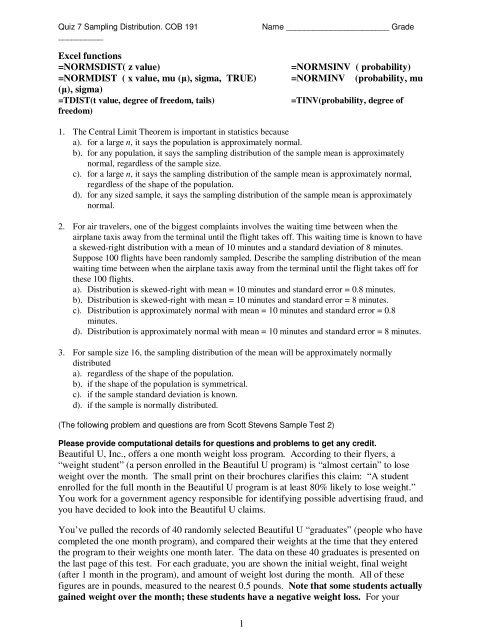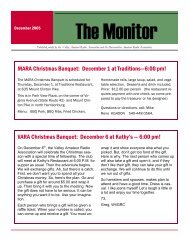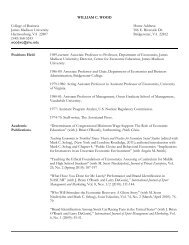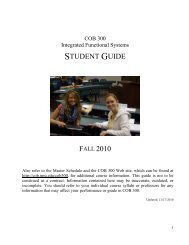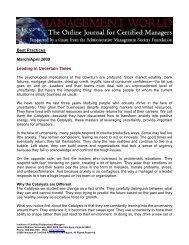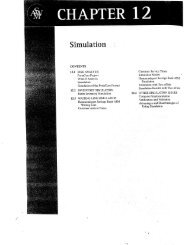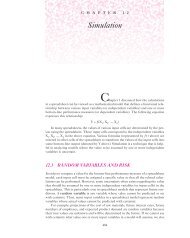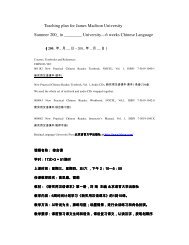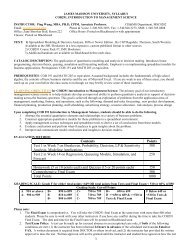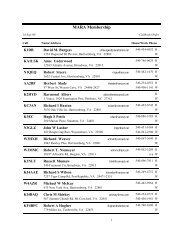1 Excel functions =NORMSDIST( z value) =NORMSINV ( probability ...
1 Excel functions =NORMSDIST( z value) =NORMSINV ( probability ...
1 Excel functions =NORMSDIST( z value) =NORMSINV ( probability ...
Create successful ePaper yourself
Turn your PDF publications into a flip-book with our unique Google optimized e-Paper software.
Quiz 7 Sampling Distribution. COB 191 Name _______________________ Grade<br />
__________<br />
<strong>Excel</strong> <strong>functions</strong><br />
<strong>=NORMSDIST</strong>( z <strong>value</strong>) <strong>=NORMSINV</strong> ( <strong>probability</strong>)<br />
=NORMDIST ( x <strong>value</strong>, mu (µ), sigma, TRUE) =NORMINV (<strong>probability</strong>, mu<br />
(µ), sigma)<br />
=TDIST(t <strong>value</strong>, degree of freedom, tails) =TINV(<strong>probability</strong>, degree of<br />
freedom)<br />
1. The Central Limit Theorem is important in statistics because<br />
a). for a large n, it says the population is approximately normal.<br />
b). for any population, it says the sampling distribution of the sample mean is approximately<br />
normal, regardless of the sample size.<br />
c). for a large n, it says the sampling distribution of the sample mean is approximately normal,<br />
regardless of the shape of the population.<br />
d). for any sized sample, it says the sampling distribution of the sample mean is approximately<br />
normal.<br />
2. For air travelers, one of the biggest complaints involves the waiting time between when the<br />
airplane taxis away from the terminal until the flight takes off. This waiting time is known to have<br />
a skewed-right distribution with a mean of 10 minutes and a standard deviation of 8 minutes.<br />
Suppose 100 flights have been randomly sampled. Describe the sampling distribution of the mean<br />
waiting time between when the airplane taxis away from the terminal until the flight takes off for<br />
these 100 flights.<br />
a). Distribution is skewed-right with mean = 10 minutes and standard error = 0.8 minutes.<br />
b). Distribution is skewed-right with mean = 10 minutes and standard error = 8 minutes.<br />
c). Distribution is approximately normal with mean = 10 minutes and standard error = 0.8<br />
minutes.<br />
d). Distribution is approximately normal with mean = 10 minutes and standard error = 8 minutes.<br />
3. For sample size 16, the sampling distribution of the mean will be approximately normally<br />
distributed<br />
a). regardless of the shape of the population.<br />
b). if the shape of the population is symmetrical.<br />
c). if the sample standard deviation is known.<br />
d). if the sample is normally distributed.<br />
(The following problem and questions are from Scott Stevens Sample Test 2)<br />
Please provide computational details for questions and problems to get any credit.<br />
Beautiful U, Inc., offers a one month weight loss program. According to their flyers, a<br />
“weight student” (a person enrolled in the Beautiful U program) is “almost certain” to lose<br />
weight over the month. The small print on their brochures clarifies this claim: “A student<br />
enrolled for the full month in the Beautiful U program is at least 80% likely to lose weight.”<br />
You work for a government agency responsible for identifying possible advertising fraud, and<br />
you have decided to look into the Beautiful U claims.<br />
You’ve pulled the records of 40 randomly selected Beautiful U “graduates” (people who have<br />
completed the one month program), and compared their weights at the time that they entered<br />
the program to their weights one month later. The data on these 40 graduates is presented on<br />
the last page of this test. For each graduate, you are shown the initial weight, final weight<br />
(after 1 month in the program), and amount of weight lost during the month. All of these<br />
figures are in pounds, measured to the nearest 0.5 pounds. Note that some students actually<br />
gained weight over the month; these students have a negative weight loss. For your<br />
1
convenience, there is also a column recording whether a student lost weight (0 = “no weight<br />
lost”, 1 = “some weight lost”).<br />
The pulled records reveal that only 24 on the 40 graduates achieved any weight loss during<br />
the month. That means that only 60% of the records pulled demonstrate any weight loss. The<br />
question you must now consider is: is this evidence strong enough to justify an accusation of<br />
false advertising by Beautiful U?<br />
THE QUESTION:<br />
Suppose that the average weight lost by a student in the program is 5 pounds, with a<br />
standard deviation of 20 pounds. How likely is it that the average weight loss in a<br />
random sample of 40 students will be 8.45 pounds or more?<br />
4. Our task to find the <strong>probability</strong> that something is greater than or equal to 8.45. What is that “something”?<br />
a) z b) σ c) s d) µ e) x (x-bar)<br />
5. Our sample size is 40, so we’ll be able to apply our 191 techniques to answer THE QUESTION. This is<br />
because the histogram of a 40 student sample suggests that the population is<br />
a) perfectly normal b) roughly normal c) roughly symmetric d) roughly binomial e) bimodal<br />
6. Question #2 says that “we’ll be able to apply our 191 techniques to answer THE QUESTION”. This is<br />
because the observation that we made in Question #2 allows us to conclude that<br />
a). the population is approximately normal<br />
b). µ is approximately normal<br />
c). the sampling distribution of the mean is approximately normal<br />
d). s is a good approximation for σ<br />
e). µ is a good approximation for x .<br />
7. To answer THE QUESTION, we need to find<br />
the standard deviation of the sampling<br />
distribution of the mean. It is equal to<br />
a). 20<br />
b). 20/40 = 0.5<br />
c). (8.45 - 5)/20 = 0.1725<br />
d). SQRT(8.45 × (20 – 8.45)/40) = 1.562<br />
e). 20/SQRT(40) = 3.162<br />
2<br />
8. We also need to know the mean of the<br />
sampling distribution of the mean. In this<br />
problem, this is<br />
a). <strong>=NORMSINV</strong>(0.1725) = -0.9443<br />
b). <strong>=NORMSINV</strong>(1-0.1725) = 0.9443<br />
c). 5<br />
d). =SQRT(40) = 6.325<br />
e). 8.45<br />
9. Which calculation would give the <strong>probability</strong> that one student chosen at random from the Beautiful U<br />
graduates would have lost 8.45 pounds or more? (Assume, for this problem only, that weight loss is<br />
normally distributed.)<br />
a). = NORMDIST( 5, 8.45, 20, TRUE)<br />
b). = NORMDIST( 5, 8.45, 3.162, TRUE)<br />
c). = NORMDIST( 8.45, 5, 20, TRUE)<br />
d). =1 - NORMDIST( 8.45, 5, 20, TRUE)<br />
e). =1 - NORMDIST( 8.45, 5, 3.162, TRUE)<br />
10. Suppose that the answer to THE QUESTION is 0.1376. What does this mean?<br />
a). About 14% of all Beautiful U students lose 5 pounds or more.<br />
b). About 14% of all Beautiful U students lose 8.45 pounds or more.<br />
c). About 14% of the students in a sample of 40 students would be expected to lose 5 pounds or more.<br />
d). About 14% of the students in a sample of 40 students would be expected to lose 8.45 pounds or more.<br />
e). None of these interpretations is correct.
11. Suppose that the answer to THE QUESTION is 0.1376. Use this information to answer this question: How<br />
likely is it that the average weight loss in a random sample of 40 Beautiful U students is between 1.55<br />
pounds and 5 pounds? (Hint: Note that 1.55 + 3.45 = 5, and that 5 + 3.45 = 8.45. Draw a picture.)<br />
i. a) About 14%. b) About 21% c) About 29% d) About 36% e) About 86%<br />
12. Use the excerpt from Table E.2b appearing on the last page of this test to compute<br />
P(-0.23 < z < 0.58). Its <strong>value</strong> is<br />
i. a) 0.2888 b) 0.310 0 c) 0.690 0 d) 0.7112 e) 1.128<br />
13. Consider these <strong>Excel</strong> expressions:<br />
i. <strong>=NORMSINV</strong>(NORMSDIST(2))<br />
ii. <strong>=NORMSDIST</strong>(NORMSINV(2)).<br />
iii. Which of the following statements is true about the <strong>value</strong>s that <strong>Excel</strong> assigns to these expressions?<br />
(You may wish to draw a picture.)<br />
iv. both expressions equal 2.<br />
v. I equals 2, II is undefined.<br />
vi. I is undefined, II equals 2.<br />
vii. both expressions are undefined.<br />
viii. the expressions are equal, but the <strong>value</strong> is probably not 2.<br />
14. Consider these <strong>Excel</strong> expressions:<br />
i. <strong>=NORMSINV</strong>(0.3)<br />
ii. <strong>=NORMSINV</strong>(0.7).<br />
Which of the following statements is true about the <strong>value</strong>s that <strong>Excel</strong> assigns to these expressions?<br />
(Hint: draw a picture.)<br />
a). both expressions give the same <strong>value</strong> (i.e., I = II)<br />
b). the <strong>value</strong> assigned to the two expressions add to one (i.e., I + II = 1)<br />
c). the <strong>value</strong> assigned to the second expression is the negative of the <strong>value</strong> assigned to the first (i.e., II = -<br />
I).<br />
d). The difference of the two <strong>value</strong>s would equal <strong>=NORMSINV</strong>(0.4)<br />
e). (i.e., II – I = NORMSINV(0.4))<br />
f). The difference of the two <strong>value</strong>s would equal <strong>=NORMSINV</strong>(0.5) (i.e., II – I = NORMSINV(0.5))<br />
15. Which of the following <strong>Excel</strong> expressions would give exactly the same <strong>value</strong> as <strong>=NORMSDIST</strong>(0.6)?<br />
a). =NORMDIST(0.6, 1, 0, TRUE)<br />
b). =NORMDIST(0.6, 0, 1, TRUE)<br />
c). =NORMDIST(0.6, 1, 1, TRUE)<br />
3<br />
d) =NORMDIST(0.6, 1, 0,<br />
FALSE)<br />
e) <strong>=NORMSINV</strong>(0.4)
Weight<br />
before<br />
program<br />
weight after<br />
program<br />
lost<br />
weight?<br />
weight<br />
loss<br />
189.5 198.0 0 -8.5<br />
186 208.0 0 -22.0<br />
175.5 176.0 0 -0.5<br />
210 174.0 1 36.0<br />
182 156.5 1 25.5<br />
178 172.5 1 5.5<br />
214 188.5 1 25.5<br />
196 158.0 1 38.0<br />
160 155.5 1 4.5<br />
184 191.5 0 -7.5<br />
184.5 148.5 1 36.0<br />
171.5 123.0 1 48.5<br />
176.5 151.5 1 25.0<br />
160.5 169.0 0 -8.5<br />
161.5 138.0 1 23.5<br />
188 177.0 1 11.0<br />
180.5 153.0 1 27.5<br />
198 192.0 1 6.0<br />
175 180.5 0 -5.5<br />
175.5 179.0 0 -3.5<br />
171 168.5 1 2.5<br />
170 181.0 0 -11.0<br />
165.5 139.5 1 26.0<br />
192 189.5 1 2.5<br />
157 165.5 0 -8.5<br />
185.5 175.0 1 10.5<br />
183 192.0 0 -9.0<br />
213.5 187.5 1 26.0<br />
162 189.5 0 -27.5<br />
207 209.5 0 -2.5<br />
184 162.5 1 21.5<br />
221.5 239.0 0 -17.5<br />
163.5 157.5 1 6.0<br />
158 176.5 0 -18.5<br />
158.5 179.0 0 -20.5<br />
230.5 219.5 1 11.0<br />
165 137.5 1 27.5<br />
177 178.5 0 -1.5<br />
171.5 138.5 1 33.0<br />
174.5 143.0 1 31.5<br />
average loss= 8.45 pounds<br />
# losing wt = 24 students<br />
# of graduates<br />
12<br />
10<br />
8<br />
6<br />
4<br />
2<br />
0<br />
z 0.00 0.01 0.02 0.03 0.04 0.05 0.06 0.07 0.08 0.09<br />
-0.5 0.3085 0.3050 0.3015 0.2981 0.2946 0.2912 0.2877 0.2843 0.2810 0.2776<br />
-0.4 0.3446 0.3409 0.3372 0.3336 0.3300 0.3264 0.3228 0.3192 0.3156 0.3121<br />
-0.3 0.3821 0.3783 0.3745 0.3707 0.3669 0.3632 0.3594 0.3557 0.3520 0.3483<br />
-0.2 0.4207 0.4168 0.4129 0.4090 0.4052 0.4013 0.3974 0.3936 0.3897 0.3859<br />
-0.1 0.4602 0.4562 0.4522 0.4483 0.4443 0.4404 0.4364 0.4325 0.4286 0.4247<br />
0 0.5000 0.5040 0.5080 0.5120 0.5160 0.5199 0.5239 0.5279 0.5319 0.5359<br />
0.1 0.5398 0.5438 0.5478 0.5517 0.5557 0.5596 0.5636 0.5675 0.5714 0.5753<br />
0.2 0.5793 0.5832 0.5871 0.5910 0.5948 0.5987 0.6026 0.6064 0.6103 0.6141<br />
0.3 0.6179 0.6217 0.6255 0.6293 0.6331 0.6368 0.6406 0.6443 0.6480 0.6517<br />
0.4 0.6554 0.6591 0.6628 0.6664 0.6700 0.6736 0.6772 0.6808 0.6844 0.6879<br />
0.5 0.6915 0.6950 0.6985 0.7019 0.7054 0.7088 0.7123 0.7157 0.7190 0.7224<br />
Entry represents area under the cumulative standardized normal distribution from -infinity to Z<br />
4<br />
-30 to<br />
-20-<br />
Weight Loss of 40 Graduates<br />
-20 to<br />
-10-<br />
-10 to<br />
0-<br />
0 to<br />
10-<br />
10 to<br />
20-<br />
# of pounds lost<br />
20 to<br />
30-<br />
30 to<br />
40-<br />
40 to<br />
50-


